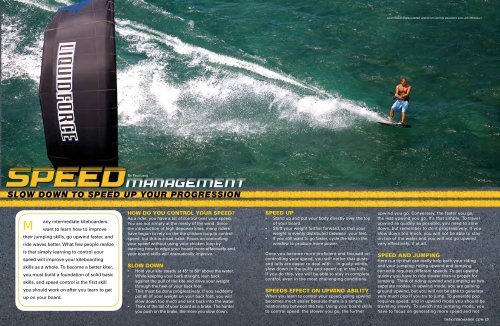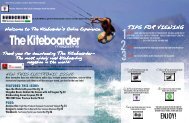“Warning Cabarete Local” graphics. –rr - The Kiteboarder Magazine
“Warning Cabarete Local” graphics. –rr - The Kiteboarder Magazine
“Warning Cabarete Local” graphics. –rr - The Kiteboarder Magazine
You also want an ePaper? Increase the reach of your titles
YUMPU automatically turns print PDFs into web optimized ePapers that Google loves.
By Paul Lang<br />
Slow Down to SpeeD Up YoUr progreSSion<br />
M<br />
any intermediate kiteboarders<br />
want to learn how to improve<br />
their jumping skills, go upwind faster, and<br />
ride waves better. What few people realize<br />
is that simply learning to control your<br />
speed will improve your kiteboarding<br />
skills as a whole. To become a better kiter,<br />
you must build a foundation of solid basic<br />
skills, and speed control is the first skill<br />
you should work on after you learn to get<br />
up on your board.<br />
How do you control your Speed?<br />
As a rider, you have a lot of control over your speed.<br />
You are not simply at the mercy of the wind. Since<br />
the introduction of high depower kites, many riders<br />
have begun to rely on the the chicken loop to control<br />
speed, but this is a bad habit. Focus on controlling<br />
your speed without using your chicken loop by<br />
learning how to edge your board more effectively and<br />
your board skills will dramatically improve.<br />
Slow down<br />
• Hold your kite steady at 45 o to 60 o above the water.<br />
• While keeping your back straight, lean back<br />
against the pull of the kite and drive your weight<br />
through the heel of your back foot.<br />
• This must be done progressively. If you suddenly<br />
put all of your weight on your back foot, you will<br />
slow down too much and sink back into the water.<br />
• Think of the tail of your board as a brake. <strong>The</strong> harder<br />
you push on the brake, the more you slow down.<br />
Speed Control<br />
Speed up<br />
• Stand up and put your body directly over the top<br />
of your board.<br />
• Shift your weight further forward, so that your<br />
weight is evenly distributed between your feet.<br />
• If you still want to go faster, cycle the kite in the<br />
window to produce more power.<br />
Once you become more proficient and focused on<br />
controlling your speed, you will notice that gusts<br />
and lulls are easier to deal with -- in gusty winds,<br />
slow down in the puffs and speed up in the lulls.<br />
If you do this, you will be able to stay in complete<br />
control, even in the most challenging conditions.<br />
SpeedS eFFect on upwind aBility<br />
When you learn to control your speed, going upwind<br />
becomes much easier because there is a simple<br />
relationship between the two. Using your board skills<br />
to control speed, the slower you go, the further<br />
Jason Slezak displays perfect upwind form and kite placement. Lens John Bilderback<br />
upwind you go. Conversely, the faster you go,<br />
the less upwind you go. It’s that simple. To travel<br />
upwind as quickly as possible, you need to slow<br />
down, but remember to do it progressively. If you<br />
slow down too much, you will not be able to stay<br />
on top of the water and you will not go upwind<br />
very effectively, if at all.<br />
Speed and Jumping<br />
Here is a tip that can really help both your riding<br />
and your jumping: riding upwind and jumping<br />
correctly requires different speeds. To get upwind<br />
quickly you have to ride slower than is proper for<br />
jumping. Think of riding upwind and jumping as two<br />
separate modes. In upwind mode, you are gaining<br />
ground upwind, but you will not be able to generate<br />
very much pop if you try to jump. To generate pop<br />
requires speed, and in upwind mode you should be<br />
traveling slowly. To switch into jumping mode, you<br />
have to focus on generating more speed and not<br />
56 thekiteboarder.com thekiteboarder.com 57













